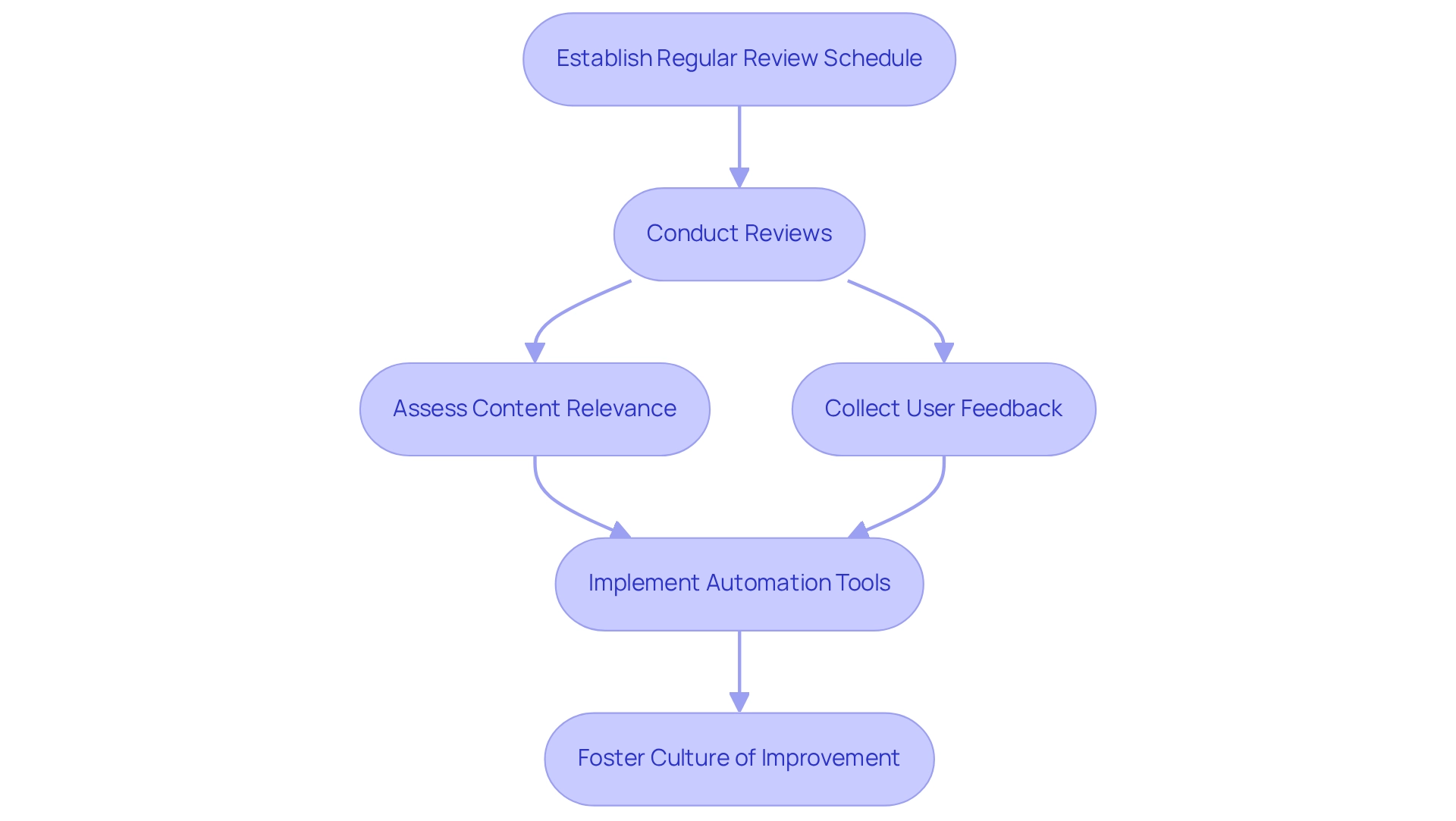
Knowledge Management through Documentation
|
July 15, 2025
|
Set Up Guides: Essential Steps for Operations Managers
Overview
You might be wondering how operations managers can create effective setup guides that really make a difference. Well, this article breaks it down for you! It highlights the essential steps that not only help align teams with organizational goals but also boost operational efficiency. By taking a systematic approach to guide creation—think resource preparation, setting clear objectives, and keeping everything updated—you can foster a culture of continuous improvement. This way, you’ll reduce errors in operations management and make your team’s life a whole lot easier. So, let’s dive into how you can make this work for you!
Key Highlights:
- Setup guides are essential in operations management, aligning teams with organizational goals and reducing errors.
- Structured guides serve as training resources for onboarding and reference tools for current employees, promoting continuous improvement.
- Platforms like SowFlow simplify the creation and updating of manuals, enhancing access to resources.
- American companies waste 21 million tons of paper annually, highlighting the need for effective digital record-keeping.
- 97% of companies lack strong document management processes, leading to operational inefficiencies.
- Operations managers should gather resources, set clear objectives, and use documentation software to streamline guide creation.
- Best practices for preparing resources include auditing existing documentation and involving team members in the process.
- A systematic approach to creating guides involves outlining structure, drafting content, incorporating visuals, and organizing for accessibility.
- Regularly maintaining and updating guides is crucial to keep them relevant and effective, with automation tools aiding in this process.
- Frequent revisions foster a culture of ongoing improvement, essential for adapting to changes in operational practices.
Introduction
In the ever-changing world of operations management, you might be wondering just how important well-structured guides really are. These invaluable resources are like the backbone of effective process documentation, helping teams align with organizational goals while cutting down on errors and miscommunication. As businesses chase after efficiency and productivity, the need for these guides becomes even more crucial, especially in a fast-paced environment where adaptability is key.
Now, let’s talk about how tools like SowFlow are changing the game. With these innovations, creating and maintaining guides has become a breeze, allowing organizations to nurture a culture of continuous improvement and knowledge sharing. This article will explore the essential aspects of developing operational guides—everything from grasping their purpose to implementing best practices that keep them relevant in a constantly evolving business landscape.
Understand the Purpose of Guides in Operations Management
Set up guides are extremely important in operations management. They provide set up guides that offer a structured way to record activities and procedures, which helps align your team with organizational goals and methodologies. This alignment significantly cuts down on errors and miscommunication. Plus, having a solid framework not only boosts productivity but also ramps up efficiency across teams. You might be wondering why this matters—well, operations managers should realize that well-structured materials do double duty. They're essential training resources for onboarding new hires and handy reference tools for current employees. This dual functionality really promotes a culture of continuous improvement and knowledge sharing, which is crucial in today’s fast-paced business world, especially when we set up guides.
Now, let’s dive into how platforms like SowFlow can make your life easier. They give teams immediate access to resources, turning the creation of manuals into a breeze. Imagine invoking the knowledge of your records with just a single command—no more unnecessary meetings to hunt for answers! Plus, updating and revising materials is a cinch, ensuring that your guides remain relevant and precise over time.
And here’s a staggering fact: American enterprises waste around 21 million tons of paper each year, with 7.5% of that material going missing. This kind of waste really underscores the urgent need for effective digital record-keeping solutions. After all, excessive paper use doesn’t just hurt operational efficiency; it also takes a toll on the environment. As Haisam Abdel Malak puts it, "Excessive paper use impacts the environment, contributing to deforestation and waste."
But wait, there’s more! A shocking 97% of companies lack strong document management processes, which can really hold them back in the competitive landscape. The case study titled 'Lack of Document Management Processes' highlights that without organized record-keeping practices, organizations become vulnerable to inefficiencies and operational hiccups. By introducing detailed resources, such as set up guides, especially given the increased demand for accessible document management solutions during the COVID-19 pandemic, organizations can tackle these challenges head-on, optimize operations, and foster a more organized approach to knowledge management.
Prepare Your Resources and Define Objectives
You might be wondering where to start to set up guides for effective operations. Well, operations managers need to gather all the necessary resources, like existing materials, software tools, and input from team members. Establishing clear goals is crucial; these goals might focus on enhancing onboarding methods, standardizing procedures, or ensuring adherence to regulations. Did you know that 98% of leaders believe strategy execution often takes more time than strategy development? This really emphasizes the need for a well-organized approach in documentation efforts.
Now, let’s dive into how specialized tools can help! Using documentation software can significantly streamline the creation process. For instance, SowFlow's software offers features like immediate user manual creation and smooth workflow capture, making it easier for operations managers to create detailed documentation. By setting specific, measurable goals, you can ensure that the guides not only fulfill their intended purpose but also align with your organization’s broader strategic objectives. As Microsoft highlights, nearly two-thirds of surveyed leaders say their companies use performance-management tools to set and track goals, showcasing the importance of these tools in record-keeping. Plus, a case study found that 82% of workers consider transparency essential for achieving company goals, suggesting that clear documentation can boost engagement and alignment within teams.
When it comes to preparing resources, best practices include:
- Conducting thorough audits of existing documentation
- Actively involving team members in the process
This collaborative approach not only enhances the quality of the manuals but also builds a culture of shared responsibility for achieving operational excellence. By focusing on these elements, operations managers can set up guides to create comprehensive user manuals that improve efficiency and effectiveness across their organizations. If you’re curious about how our platform can transform your documentation process with immediate user assistance and smooth workflow capture, reach out to us today! Moving forward, it’s crucial to implement the established goals and consistently review the instructions to ensure they remain relevant and effective.
Create and Organize Your Guides Step-by-Step
If you take a systematic approach, you can easily set up guides to create effective operational guides with SowFlow. You might be wondering where to start, so let’s break it down:
- Outline the Structure: Kick things off with a solid outline that includes key sections like objectives, procedures, and troubleshooting tips. This foundational step is crucial for ensuring clarity and organization.
- Draft Content: Next up, write clear and concise directions for each step. Use straightforward language and steer clear of jargon to make sure everyone can understand the content. With SowFlow, crafting user guides is a piece of cake, allowing for quick updates and revisions to keep your documentation fresh in a fast-paced business world.
- Incorporate Visuals: Don’t forget to add visuals! Diagrams, screenshots, or flowcharts can really help illustrate complex processes. The great thing about SowFlow is that you can capture visuals right from your browser, making the creation of SOPs and training materials so much smoother. Research shows that visual aids can boost comprehension, helping users grasp concepts quickly and effectively.
- Review and Revise: After you’ve drafted your guide, involve your team in reviewing the documents. Getting feedback is essential, and as Henry Ford wisely said, "Coming together is a beginning; keeping together is progress; working together is success." This collaborative spirit not only improves usability but also fosters a sense of ownership among team members.
- Organize for Accessibility: Finally, make sure to store your resources in a centralized spot, like a shared drive or information platform. This way, they’re easily accessible to everyone, including those co-workers working on standard operating procedures (SOPs). With this platform, your team can efficiently produce and organize documentation, cutting down the time spent searching for information and promoting effective knowledge sharing.
By following these steps and leveraging the platform’s features, operations managers can set up guides that help streamline processes and boost team productivity. As Product Owner Anastasia Masadi puts it, "This platform has been a game changer in the way we document work and deliver to our clients." I no longer have to take each screenshot separately, and I can create SOPs and training materials without ever leaving my browser. It’s truly given me some time back in my life!
Maintain and Update Your Guides Regularly
You might be wondering how to keep your operational protocols effective over time. Well, establishing a regular review schedule—think quarterly or bi-annually—can really help, especially as your organization evolves. During these reviews, it’s a good idea to assess how relevant the content is, spot any outdated procedures, and bring in user feedback. Encouraging your team to report discrepancies or suggest improvements not only enhances the process but also creates a collaborative environment.
Now, let’s talk about automation tools. They can be a lifesaver for setting reminders for updates and making it easy to create and tweak user manuals. This way, all your materials stay in line with the latest operational practices. Plus, with tools like SowFlow, your team can access resources instantly, which really streamlines process standardization, onboarding, and knowledge sharing—boosting overall efficiency.
Frequent revisions are key! Not only do they increase the usefulness of your resources, but they also help cultivate a culture of ongoing improvement within your organization. This is especially crucial in areas like transfer pricing documentation, where annual reviews are necessary to keep up with current economic conditions. And as Dennis Olsson, Danske Bank’s group sustainability change lead, puts it, "Change management is not about filling in change tools and templates." This really drives home the point that maintaining your operational set up guides is a vital part of a broader change management strategy.

Conclusion
You might be wondering why well-structured operational guides are such a big deal. Well, they’re essential for fostering efficiency, productivity, and alignment within organizations. Think of them as a comprehensive resource for training new employees and providing ongoing support to current staff. This not only promotes a culture of knowledge sharing but also encourages continuous improvement. With tools like SowFlow, creating these guides has become a breeze, allowing for quick updates and easy access to documentation—something we all know is crucial in today’s fast-paced business world.
Now, let’s dive into what it takes to create effective guides. It involves a systematic approach:
- Outlining structures
- Drafting clear content
- Incorporating visuals
- Facilitating team collaboration
This way, your guides won’t just be informative; they’ll also be engaging and accessible to everyone. Plus, keeping these guides fresh and regularly updated is vital. It helps organizations stay relevant and adapt to changing practices while incorporating valuable team feedback.
In summary, we can’t overstate the importance of developing comprehensive operational guides. They’re not just a set of instructions; they’re a strategic asset that can significantly boost your organization’s performance. By leveraging innovative documentation tools and committing to continuous improvement, you can navigate the complexities of operations management with confidence and agility. So, let’s embrace this journey together and drive success in our ever-evolving landscape!
Frequently Asked Questions
Why are set up guides important in operations management?
Set up guides are crucial as they provide a structured way to record activities and procedures, helping align teams with organizational goals and methodologies, which reduces errors and miscommunication.
How do set up guides benefit productivity and efficiency?
A solid framework from set up guides boosts productivity and ramps up efficiency across teams by providing clear instructions and reducing confusion.
What dual function do set up guides serve?
Set up guides serve as essential training resources for onboarding new hires and as handy reference tools for current employees, promoting a culture of continuous improvement and knowledge sharing.
How can platforms like SowFlow assist with set up guides?
SowFlow provides teams with immediate access to resources, simplifies the creation of manuals, and makes updating and revising materials easy, ensuring guides remain relevant and precise.
What environmental impact does excessive paper use have?
Excessive paper use contributes to deforestation and waste, negatively affecting operational efficiency and harming the environment.
What percentage of companies lack strong document management processes?
A staggering 97% of companies lack strong document management processes, which can hinder their competitiveness.
What challenges do organizations face without organized record-keeping practices?
Organizations without organized record-keeping are vulnerable to inefficiencies and operational hiccups, which can negatively impact their performance.
How can set up guides help organizations during the COVID-19 pandemic?
By introducing detailed resources like set up guides, organizations can tackle challenges related to document management, optimize operations, and foster a more organized approach to knowledge management.
👍
What others are liking
5 Steps to outline your ideal documentation structure
5 MINS READ
Where to start the your journey of mapping out your ideal documentation structure, aligning it with the very heartbeat of your organization?
Defining a winning level of detail in your process
3 MINS READ
What is too much detail, and what is too little? This article described in that winning level detail about what detail is enough.





